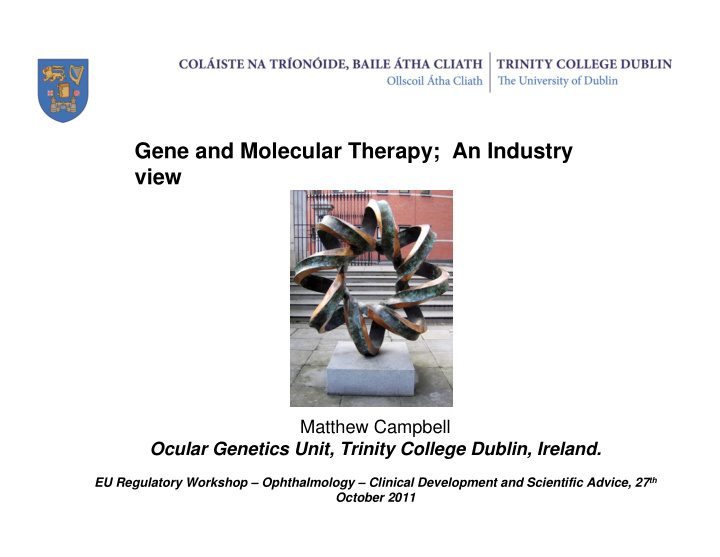



Gene and Molecular Therapy; An Industry view Matthew Campbell Ocular Genetics Unit, Trinity College Dublin, Ireland. EU Regulatory Workshop – Ophthalmology – Clinical Development and Scientific Advice, 27 th October 2011
Of the almost 200 million world-wide cases of visual handicap, degenerative retinopathies figure prominently. Preventive therapies are currently limited, or in many cases non- existent Age-related macular degeneration Retinitis pigmentosa
Retinitis pigmentosa The most prevalent cause of registered visual handicap among those of working age - possibly the most genetically heterogeneous of any hereditary condition for which molecular pathologies have been explored 1989: Rhodopsin, 3q RDS-peripherin, 6p1991 I 1 2 II 1 2 3 III Inosine monophosphate 1 6 2 7 3 8 4 9 5 10 IV 1 28 2 3 4 5 7 8 9 10 11 12 13 14 15 29 16 18 19 20 21 22 23 24 25 26 27 6 17 Dehydrogenase 1, 7q, 1993 V 21 1 2 3 4 5 6 7 8 10 11 12 13 14 16 17 18 19 20 9 15 VI 1 Current situation: RP/LCA/syndromic forms of retinopathy: 202 loci – 161 genes. Probably as many more remain to be identified.
Age-related macular degeneration Multifactorial Risk factors identified in genes encoding components of the complement cascades. CFH risk allele 402H, now known to have reduced capacity to sequester MDA, a pro-inflammatory product of lipid peroxidation. Weissman et al., Nature 478 (2011) 76-81 Therapies: Dry (non-exudative) form : no current means of therapeutic intervention. Wet (exudative) form : Monoclonal antibody targeting VEGF (Lucentis) requires regular (monthly) invasive intra-ocular inoculation with risk of vision loss. No endpoints for treatment have been established
The challenge “To design and validate gene and molecular therapies for degenerative retinal diseases that are applicable to a broad range of molecular pathologies”
Neuronal Barrier Modulation A new non-invasive technology for systemic drug treatment of degenerative retinopathies Pre-emptive systemic molecular therapy for early-stage age-related macular degeneration and Retinitis pigmentosa
The Problem • 98% of drugs with established potential for treating neurological diseases do not easily diffuse across the BBB or iBRB. • Systemic delivery of such compounds is either impractical or highly inefficient. • Poor penetration of these compounds is as a result not only of the low rates of diffusion across tight junctions but also the presence of P-glycoprotein efflux pump activity and a range of specific efflux receptors present in the microvascular endothelium
Abbott et al., 2006
Claudin-5 •23 kDa tight junction protein •In 2003, claudin-5 knockout mice were reported to show a size-selective BBB to molecules below 800 Daltons Nitta et al., 2003
Retinal Disease Models •Age-Related Macular degeneration (AMD): Major sight threatening disease in developed countries •Current therapies are limited and invasive- Direct and regular intraocular injection of antibodies targeting VEGF. No end-point has been established for treatment.
Magnetic Resonance Imaging (MRI) Permeability experiments using Gadolinium-diethyenetriamine-penta- acetic acid injection Gd-DTPA has a MW of 742 Daltons
Ocular drug delivery by barrier modulation
Laser induced Choroidal neovascularisation (CNV) Combination therapy Administered Doxycycline in drinking water for 2 weeks while receiving 2 I.P injections of VEGF receptor antagonist Sunitinib malate (532 Da)
“The rationale was not to develop an RNAi therapeutic agent per se, but to use RNAi to allow the application of conventional drugs for treating diseases of the brain, CNS or eye”. [Professor John Rossi, commenting on the technology of Neuronal Barrier Modulation, EMBO Molecular Medicine, 2011]
End-points in different phases -Costs involved in pre-clinical safety/toxicology studies are extensive -With wet AMD, what is the end-point and efficacy readout? Duration of clinical trials -Barrier modulation is preventative as opposed to a “cure” -Is Safety/toxicology enough?
The Ocular Genetics Unit at TCD Prof. Pete Humphries Dr. Marian Humphries Dr. Anna-Sophia Kiang Dr. Paul Kenna Prof Jane Farrar Ms Anh Nguyen Mr Finnian Hanrahan Mr James Keaney Ms Ema Ozaki
Recommend
More recommend